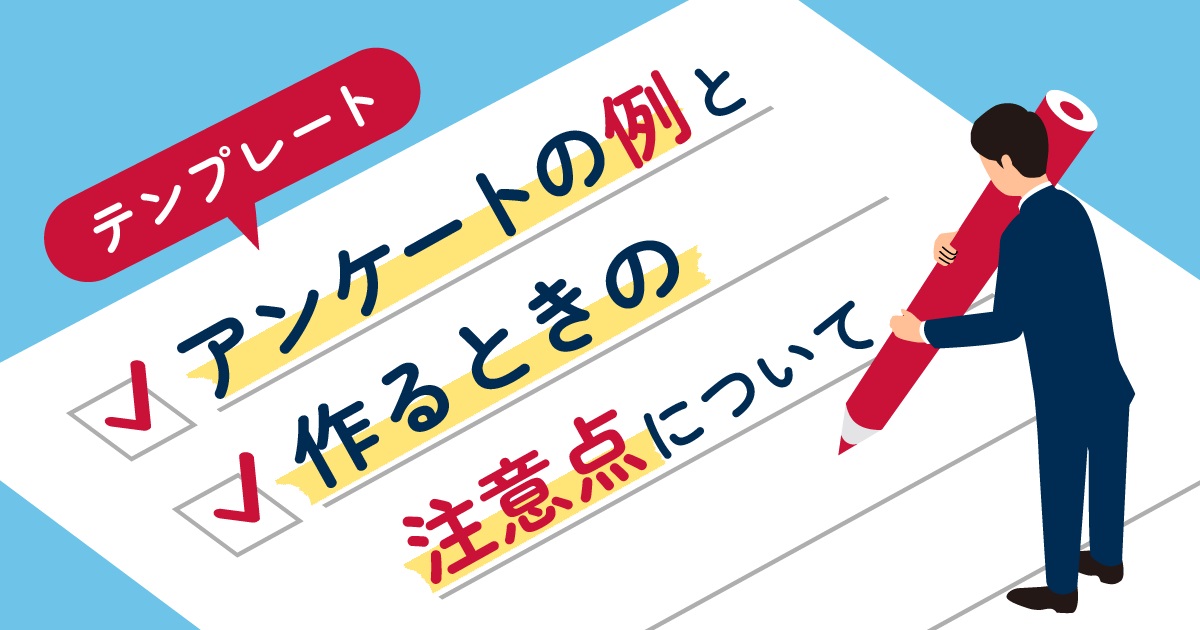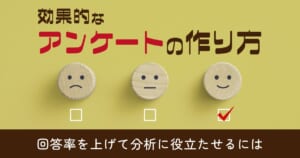How to Create an Effective Survey Questionnaire

Have you ever had opportunities to create or answer questionnaires in your company? Knowing the situation at your workplace through surveys helps you to improve employee satisfaction and identify problems. Also, this may lead to a reduction in employee turnover.
They can also be useful elements for conducting customer satisfaction and service surveys. Questionnaires are essential not only for internal but for external use, and it is important to identify the dos and don'ts when drafting them.
This article details the points to keep in mind when designing in-house questionnaires. If you are creating a questionnaire, here are some tips to follow.
Contents
- 01Find the Current Situation
- STEP 1: Establish the purpose of the survey
- STEP 2: Set the questions to be asked.
- STEP3: Set the question type
- STEP4: Ordering
- STEP 5: Create a questionnaire.
- STEP6: Prepare choices
- STEP7: Final confirmation
- 02Sample Questionnaire Template
- (1) Employee Satisfaction Questionnaire
- (2) 360-degree evaluation
- Stress Check
Find the Current Situation

First of all, grasp the current situation in the company and create a questionnaire that will help improve the work environment. Here are seven steps on how to create an effective questionnaire.
STEP 1: Establish the purpose of the survey
As a basic premise, set a purpose for why you are conducting the survey.
- Are the management policies being understood by the employees?
- Are you dissatisfied with the current way of working?
- Do you have good relationships with your supervisors and subordinates?
A survey will help you to get a variety of information as described above. As for taking a survey, nothing is more important than setting a purpose so that you can grasp the current situation in your company and to solve problems.
STEP 2: Set the questions to be asked.
Based on the goals you have set, think about the content of the questionnaire.
It is better to take into consideration which answer format is effective to choose: selective or descriptive. Also, the number of questions should be an appropriate volume so that employees can focus on and grab the content. Around five-minutes-survey would be less of a burden on them.
Ensure the content is easy to analyze after the survey.
STEP3: Set the question type
Choose the type of question. The following are examples which are often used in internal surveys.
- radio button-type
- checkbox (type)
- matrix type
- scale type
- text-box type
You can combine the above question types if necessary.
Radio button
This is the most popular type of survey. It is a circular button without a center, and is used to choose only one answer.
【Sample Question】 How do you commute to the office?
〇 On foot
〇 Bicycle
〇 Train
〇 Bus
〇 Other
Checkbox
Checkbox is likely to be implemented to get multiple responses. Use the square button and write "multiple answers available."
【Sample Question】 What can cause you stress? (multiple answers available)
□ Job description
□ Human relations
□ Commuting time
□ Overtime
□ Other
Survey Scales
Scales are used to measure a specific range of a question. It is often used to find out the level of satisfaction and feedback from employees.
【Sample Question】 Are you satisfied with your current salary? (5 levels)
〇 Satisfied
〇 Somewhat satisfied
〇 Neutral
〇 Somewhat dissatisfied
〇 Dissatisfied
Matrix Questions
A matrix is a type of questionnaire that asks people to answer multiple items with the same choices. It is often used when you want to ask the same question all at once.
【Sample Question】What is important to you in your work?
| Strongly Agree | Agree | Neutral | Disagree | Strongly Disagree | |
|---|---|---|---|---|---|
| Work Results | ✓ | ✓ | ✓ | ✓ | ✓ |
| Human Relations | ✓ | ✓ | ✓ | ✓ | ✓ |
| Company Welfare | ✓ | ✓ | ✓ | ✓ | ✓ |
Text Box
A text box is used to collect short answers. It may be placed at the end of the survey if you want to elaborate on the previous question or to get feedback freely.
【Sample Question】
Write the reason for your answer as shown in Q.xx.
STEP4: Ordering
Align your internal surveys in an order that makes them easy to answer. Respondents will feel uncomfortable if questions that are difficult to think about or answer come first. Therefore, questions that are difficult to answer should be placed at the end of the survey.
Also, placing the questions without considering the order can cause a "carry-over effect" where the previous question influences the answers to later questions, reducing the accuracy of the analysis.
Consider the order of the questions so that the respondents can answer them easily and the preparer can analyze them easily.
STEP 5: Create a questionnaire.
Create your questionnaire according to the question type.
It should be written in a simple and neutral manner, avoiding words that are unfamiliar to the respondent and roundabout expressions. The key is to keep your questions to one or two lines, concise, and easy to understand.
STEP6: Prepare choices
Make sure you have appropriate choices.
It depends on the content of the question, but in general it is recommended to prepare at least 5 questions and as many as 15. Try to avoid similar choices, as this will make it more difficult for the respondents to answer.
STEP7: Final confirmation
After you have completed steps 1 through 6, do a final check.
Check for typographical errors and whether the text is easy to understand. Especially for internal questionnaires, it is important to note that poor quality questionnaires can lead to loss of trust among employees.
Sample Questionnaire Template

Let's take a look at some examples of templates to see what kind of questionnaire companies actually use.
In this chapter, we will introduce three templates that are often used for internal surveys: Employee Satisfaction Survey, 360 Degree Feedback and Stress test.
(1) Employee Satisfaction Questionnaire
【Sample】
1. What is your age?
2. What is your department?
3. How many years have you been with the company?
4. How much do you find your current job challenging?
5. How satisfied are you with your relationships at your workplace?
6. How satisfied are you with your current job?
7. How likely would you be to recommend your current workplace to a friend?
8. How well do the following items apply to your thought? (e.g. "freedom and discretion," "achievement and cooperation")
9. Do you want to continue working at your current workplace in the future?
10. If you have any problems or requests regarding your current workplace, feel free to write them down.
Employee satisfaction surveys provide information on job satisfaction and ease of working. By analyzing the results, it is possible to improve the work environment and prevent a decline in the retention rate.
(2) 360-degree evaluation
【Sample】
1. What is your age?
2. What is your department?
3. How many years have you been with the company?
5. What is the position of Mr./Ms. xx from your point of view?
6. How well do the following items apply to Mr./Ms. xx? (Honesty, responsibility, creativity, cooperation, etc.)
7. Feel free to write your opinions about Mr./Ms. xx.
A 360-degree Feedback is conducted on employees with whom you are working, and is a method of evaluating a specific subject. By having the evaluation viewed from different perspectives, you can find the subject's abilities and skills.
The questionnaire has the advantage of allowing employees to make objective evaluations and to notice areas for improvement themselves.
Stress Check
Please check the box that best describes your situation. (4 levels)
a. About your job
(Strongly agree, Agree, Neutral, Disagree, Strongly disagree)
1. I have so many tasks.
2. I need to concentrate all the time.
3. I can work at my own pace.
4. My work is suitable for me.
b. About your condition
(Always, Often, Sometimes, Almost never)
1. Energetic
2. Frustrated
3. Constant anxiety
4. Lack of appetite, etc.
c. About human relations
(Very much, Somewhat, Hardly, Not at all)
1. Have you ever asked your boss for advice about your work?
2. Have you ever asked a colleague for advice about your work?
3. Have you ever asked a friend for advice about your work?
4. Have you ever discussed your work with your family? etc.
d. Please evaluate your level of satisfaction.
(Satisfied, Somewhat satisfied, Somewhat dissatisfied, Dissatisfied)
Stress checks are now mandatory in workplaces with 50 or more employees as a result of the revision of the Occupational Health and Safety Law. By conducting periodic questionnaires, it is possible to learn about employees' mental health problems and aim to create a safe and secure work environment.
Back to ContentsTips for Internal Questionnaire

Here are five tips to look for when creating an internal survey.
- Set items related to basic information
- Add "Other" as one of the choices
- Do not list similar choices
- Utilize the two-factor theory in employee satisfaction surveys.
- Explain the meaning of the survey to employees
Set items related to basic information
Be sure to set up a section on basic information in the first half of the survey. This is because it allows you to categorize the attributes in detail and analyze the trends of each. In the case of in-house surveys, this includes gender, position, department, and length of service.
Add "Other" as one of the choices
Include "Other" in the choices. If you don't have an "Other" option, respondents may not be able to answer any of the questions.
However, be aware that if the number of options itself is small, most respondents will choose "Other." The key is to set an appropriate number of items and add the answer choice.
Do not list similar choices
Do not include answers that are similar in content in your choices. For example, "friend" and "acquaintance" can be interpreted differently by different people. If you put these in the same option, the respondents' choices may vary and the accuracy of the survey may decrease.
If you want both answers to be included in the survey, use a checkbox type question instead of a radio button one.
Two-Factor Theory on Employee Satisfaction
The internal questionnaire was based on the research proposed by clinical psychologist Frederick Herzberg. You should be aware of the following two axes;Create them with two axes in mind: "Motivational Factors" and "Hygiene Factors."
Motivators
Motivators are what brings satisfaction at work. Aspiration to do a job, such as achievement, recognition, and promotion, fall under the category of motivators.
By incorporating these elements into your survey, you will be able to find ways to improve the motivation of your employees.
Hygiene Factors
Hygiene factors are what bring about a sense of dissatisfaction at work. Salary, human relations, and work environment fall under the category of hygiene factors.
Incorporating these elements into the questionnaire will clarify "where employees are dissatisfied," and if countermeasures are taken, they will be able to prevent the turnover rate from declining.
Explain the meaning of the survey to employees
In the preliminary internal questionnaire, explain the meaning and purpose of the survey. Clear purpose will make employees more willing to cooperate with the survey.
In order to find out what they really think, be sure to give them information such as whether they cannot be identified and whether it will not affect their personnel evaluation. This will increase the response rate of the survey.
Back to ContentsSample Request Letter

Before conducting an internal survey, a preliminary request letter is required. A well-crafted request letter will increase the survey response rate. In this section, we will present an example of an internal survey request letter sent via email.
Sample Email 1
Subject:【Respond by February12 (Mon.), 1:00 p.m.】 Questionnaire Request
To whom it may concern
This is xx from the Human Resources Department.
This email is to inform you that we are implementing a stress test questionnaire for all employees.
The survey form will be sent to you via internal mail.
We would like to receive your message by 1:00 p.m. on Monday, February 12.
Please reply to us by email.
It will take about 20 minutes for responses.
Thank you for your cooperation.
Sample Email 2
Subject: Request for internal survey
Dear Mr./Ms. xx,
Request for cooperation in new product survey
Currently, our planning department is developing a new product xx.
First, we would like to ask you about your impressions of xx.
The survey will be sent to you as an attachment.
We apologize for the inconvenience, but we would like to receive your message by 4:00 p.m. on Friday, December 10.
Please reply by internal email.
Please note that the questionnaire is anonymous, and the content of your responses will not be disclosed to any third party.
Thank you very much for your cooperation.
The key to sending an internal survey is to include a deadline and the time it will take to respond.
Also, as in the second example, a statement regarding the handling of personal information will reassure respondents and encourage them to answer honestly. Since respondents are willing to take time out of their busy schedule to cooperate with a survey, try to make sure that all the details are available in a single email message.
Back to ContentsWeb-based Internal Surveys

We recommend that in-house surveys be conducted on the Web rather than on paper (survey forms). In addition to being easier to tabulate, the Web is more suitable for analyzing results and identifying issues.
The system also makes it easier to manage response progress and tabulate results. Other advantages include the following
- fewer misspelled words and phrases
- Higher Response Rate
- Save Cost
There are many free web-based survey services available, and you can try one.
Higher Response Rate
Web-based surveys increase the response rate because respondents no longer have to print out a survey form and handwrite it, which reduces the burden on the respondent. Web-based surveys also increase response rates because busy employees can answer the survey while on the move or taking a break, using a smartphone or other device in addition to a computer.
Save Cost
Web surveys can bring significant cost reduction. Not only the one for printing the questionnaires but labor cost can be saved. Since you can save time by sending them all at one by email, labor cost comes to be saved in the end. Web surveys do not cost more than necessary and the entire process can be completed online.
Back to ContentsSummary
We introduced notes and key points on how to create an internal questionnaire, introducing a template.
The key point is to make the survey not only to understand the current situation in the company, but also to provide content that will lead to the resolution of current problems and issues. If you know how to create a survey, you can use it not only within your company, but also in various other situations, such as customer satisfaction surveys.
Web-based in-house questionnaires have more advantages than written ones, and are now becoming mainstream. Our e-learning system "learningBOX" also has a questionnaire function, which is easy to use and low-cost, so if you are considering creating an in-house questionnaire including e-learning, please contact us. Free Plan.
▼You may also like:
Back to Contents Back to Article List


















